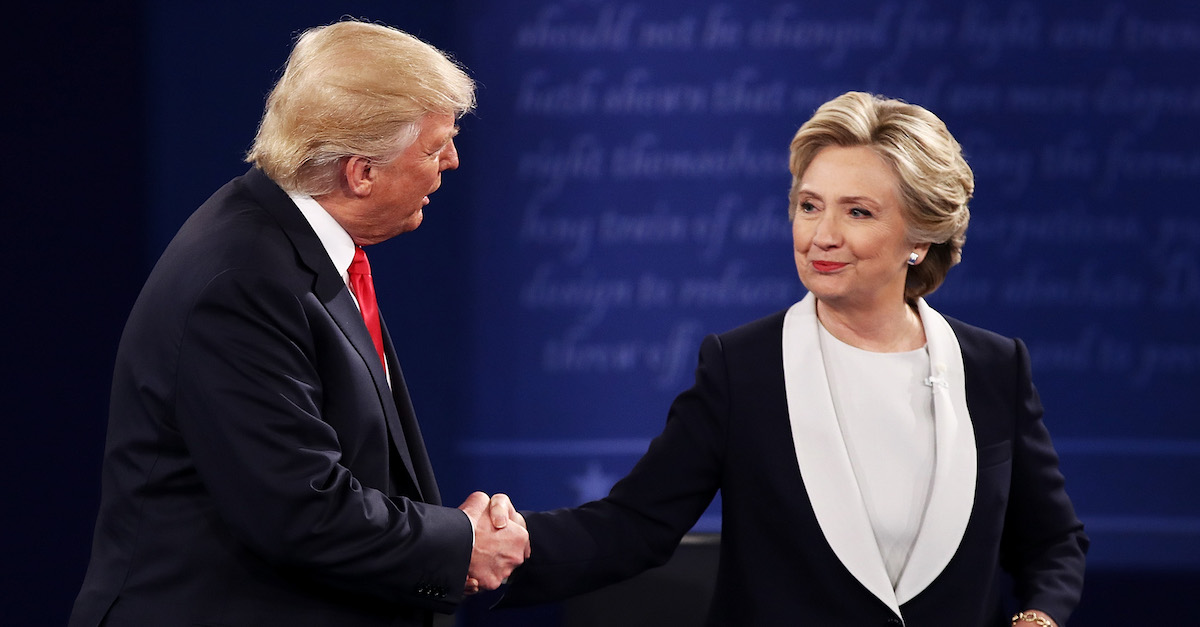
Donald Trump and Hillary Clinton debated at Washington University on October 9, 2016 in St Louis. (Photo by Win McNamee/Getty Images.)
Attorneys for Donald Trump on Thursday filed court papers to request additional time to reply to a motion to dismiss a multi-claim civil lawsuit against Hillary Clinton and a large list of other defendants. Trump’s legal team asked to file an amended complaint as another possibility.
The Democratic National Committee, the law firm Perkins Coie, that firm’s former partner Michael Sussmann, Rep. Debbie Wasserman Schultz (D-Fla. 23), Fusion GPS, Christopher Steele, former FBI Director James Comey, former FBI agent Peter Strzok, former FBI attorneys Lisa Page and Kevin Clinesmith, and former deputy FBI director Andrew McCabe are all included among the named defendants. Also sued were several “John Does” and unknown corporations.
The lawsuit alleged RICO violations, injurious falsehood, theft of trade secrets, violations of the Stored Communications Act, and other actions — 16 in total.
Clinton’s attorneys asked a federal judge on Wednesday to to throw out the voluminous complaint against a number of Democratic Party actors and others.
“Whatever the utility of [Trump’s lawsuit] as a fundraising tool, a press release, or a list of political grievances, it has no merit as a lawsuit, and should be dismissed with prejudice,” Clinton’s attorneys David Kendall and David Oscar Markus wrote in the introduction of a 29-page motion to dismiss.
“The gravamen of [Trump’s] claims concerns alleged events occurring in 2016 and 2017, so the statute of limitations on his claims expired long ago,” the motion argues, citing the Federal Rule of Civil Procedure that governs dismissals based on “time-barred” claims.
Trump’s attorneys responded on Thursday with a bi-fold request: either (1) to file an amended complaint, or (2) to have additional time to respond to Clinton’s motion to dismiss the case.
The latter request, Trump’s team argued, is only fair.
“Presently, a number of the Defendants have requested extensions of time to file responses to the Complaint,” the document indicates. “In this regard, the undersigned have been appropriately accommodating.”
The motion continues with reference to the Federal Rules of Civil Procedure:
Rule 15 F.R.Civ.P. gives the Plaintiff an advantage of being able to cure defects or otherwise improve and enhance a complaint by filing an amended complaint within 21 days of the time a Motion to Dismiss or an Answer is served.However, the benefit of that rule would be frustrated to a great extent if the Plaintiff, sub judice, were to be given the one opportunity to cure as a matter of course before 27 out of the 28 Defendants of the case at bar, have answered or moved to dismiss, as it is with certainty due to extensions which have been given that further motions to dismiss will be filed in time for the Plaintiff to cure the issues which would have been otherwise curable by filing an Amended Complaint.
“There is no question that the time afforded to file an Amended Complaint as a matter of course, in the instant case, expires on May 11, 2022, 21 days after HILLARY CLINTON filed her Motion to Dismiss,” the document continues. “It is appropriate to move for an enlargement of time to file an Amended Counterclaim, provided that the Motion for an Extension of Time is filed within 21 days of the first Motion to Dismiss, which is served.”
The document also predicts that “a large number of Defendants” will also likely move to dismiss the lawsuit.
“Therefore, the Plaintiff is not seeking a flexible date but rather an extension of 39 days to either file an Amended Complaint, as a matter of course, pursuant to Rule 15(a) or to file a Response to Hillary Clinton’s Motion to Dismiss,” it states. “In other words, the Plaintiff is seeking 60 days rather than the 21 days provided by Rule 15(a), being the 21 days in the rule plus the 39 day extension.”
A more scattershot approach to the motions to dismiss would not be helpful, according to Trump’s counsel; the extension would keep things “simple” and would “assist in terms of judicial economy for all the Motions to Dismiss to be filed, and then for the Plaintiff to do one major amendment, rather than to seek to file numerous responses to the numerous motions to dismiss.”
The plaintiff—that is, Trump—said he also needs “an opportunity to cure the deficiencies raised in those motions” to dismiss the matter.
The judge who will rule on the matter is U.S. District Judge Donald M. Middlebrooks, a judge Trump’s attorneys sought to remove from the case — because he was nominated to the bench by Bill Clinton, the husband to the primary defendant. The judge rubbished any notion that he was accordingly biased via a previous missive in the matter.
The full document is below: